Tools for making better product decisions
Practical tools and frameworks for when you’re not sure what to do next
In Annie Duke’s Thinking in Bets, the author refers to a practice called ‘resulting’. And it’s a surprisingly common mistake most of us use in decision making:
‘When I consult with executives… I ask group members to come to our first meeting with a brief description of their best and worst decisions of the previous year. I have yet to come across someone who doesn’t identify their best and worst results rather than their best and worst decisions.’
As we look to challenge ourselves to make the best decisions possible, we often judge our decision making skills on the outcomes we achieved. This isn’t quite right since the outcome itself will always be unpredictable; the results achieved are different to the decision making process which led to a decision being taken. This is known as ‘resulting’ – where you assess the quality of your decision by the outcome it achieved.
A good decision can lead to bad results, but so long as the steps you took to make that decision were sound, you can sleep safe at night knowing that you took the best action based on what you knew at the time.
Products, decisions and the decision making process
Technical decisions, strategic decisions, design decisions, scoping decisions. Products are, to a large extent, the result of the decisions made over time.
Product managers and product teams are challenged to make decisions every day.
What influences your decision making and how can you make better decisions both individually and as a team?
That’s what we’ll explore in this post.
Types of decisions
Mr Jeff Bezos famously splits decisions into two broad categories: reversible and irreversible.
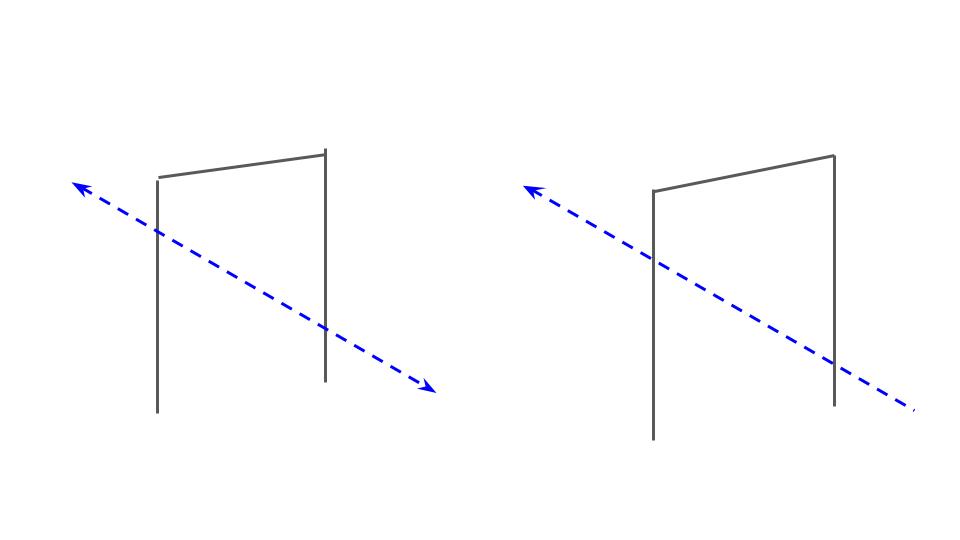
Reversible decisions are a little bit like walking through a door; you know that if you walk through it you can easily walk back the other way. If you’re faced with a decision and you know it can be easily reversed, this might mean you can make this decision more quickly. That doesn’t mean you can be reckless in your decision making, just that you are aware that the impact of a bad outcome as a consequence is limited since it can be reversed.
Irreversible decisions can’t be as easily reversed.
- Making a decision to build hardware at your startup.
- Developing a mobile app from scratch in house with a newly hired team of app engineers.
- Adopting a vertically integrated ecommerce model to own the end to end process.
These are not decisions you can reverse easily.
For larger companies, failed irreversible decisions means writing off a few million dollars, learning some important lessons and moving on. For smaller companies, failed irreversible decisions can mean it’s game over.
- MySpace made a strategic decision to sell to News International. The sellout resulted in its gradual demise.
- Wonga Loans made a tactical decision to sell loans at high interest rates. This sparked negative consumer press and ultimately the company fell into administration.
- Meerkat made a strategic decision to transform into HouseParty after the launch of Periscope. The app has celebrated success since its transformation.
Framing decisions as easily reversible and less easily reversible ‘bets’ can help you and your teams to carefully consider how you might reduce the risks upfront when you don’t have all the facts.
The decisions product teams make
Decisions you might make as a product team include strategic, tactical, scoping, technical and design.
The responsibility for each of these types of decisions usually rests with different people:
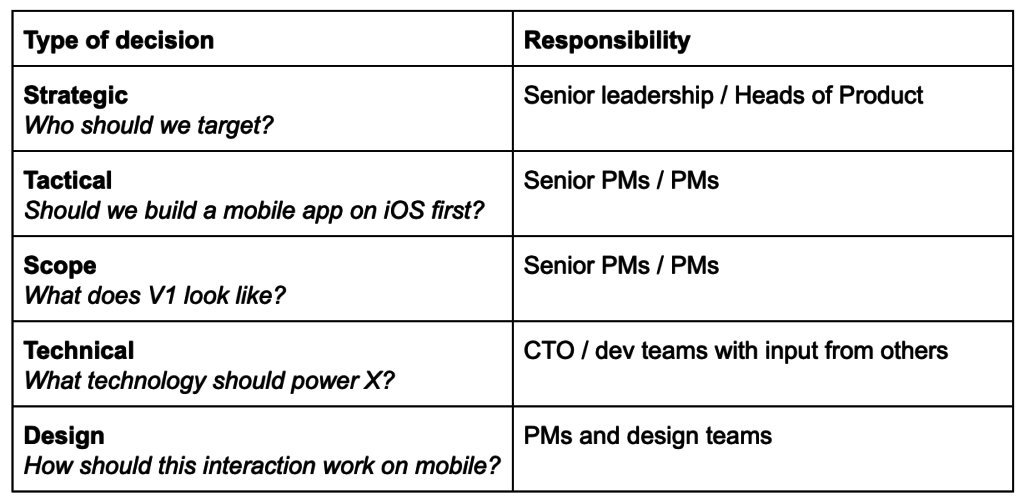
If it’s not clear who is responsible for making decisions, it helps to address this in a formal setting. A ways of working session where team members and stakeholders agree on processes for work, including decision making, is a useful way to do this.
Practical tools for when you’re making difficult decisions
Here’s a selection of decision making tools and guidelines which can be help when you’re making important decisions.
1. Principle based decision-making
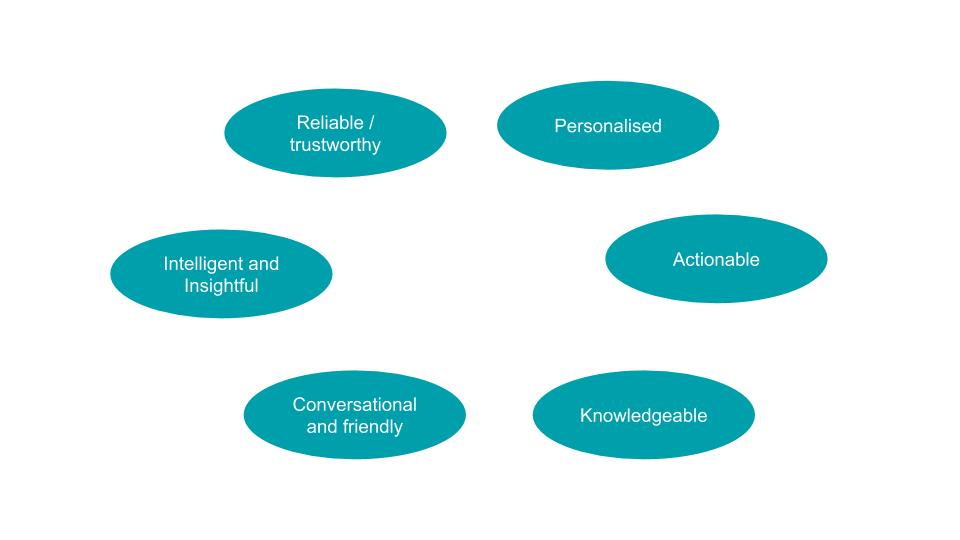
Product principles are descriptive foundational rules, guidelines and truths which help shape the decisions you make.
Use your underlying product principles to help inform your decision making. Product principles are particularly helpful for making tough strategic and design decisions.
An example of product principles might include:
- Informative and actionable
- Fresh, energetic and dynamic
- Trustworthy and honest
- Personalised
How might you apply these principles to the decision making process?
- Personalised – If you’re designing a new onboarding experience, you might decide to use personalisation tactics to increase engagement such as using the user’s name throughout the journey.
- Actionable – If you’re building a set of new reporting tools you might decide not only to show the data, but also actionable tips on what to do with that data.
- Trustworthy and honest – if your SaaS product’s customers aren’t utilising the product in the most efficient way, you might decide to proactively nudge your customers onto a different package – even if this means downsizing to a cheaper alternative.
In situations where you’re faced with a number of options with no clear path forward, reverting back to your product principles can help shed some light on what might be the best route to take, particularly with design decisions.
If you don’t have a set of product principles, aim to make it a priority to establish some as they’ll make life a lot easier in the future.
2. Pre-mortems and time travel
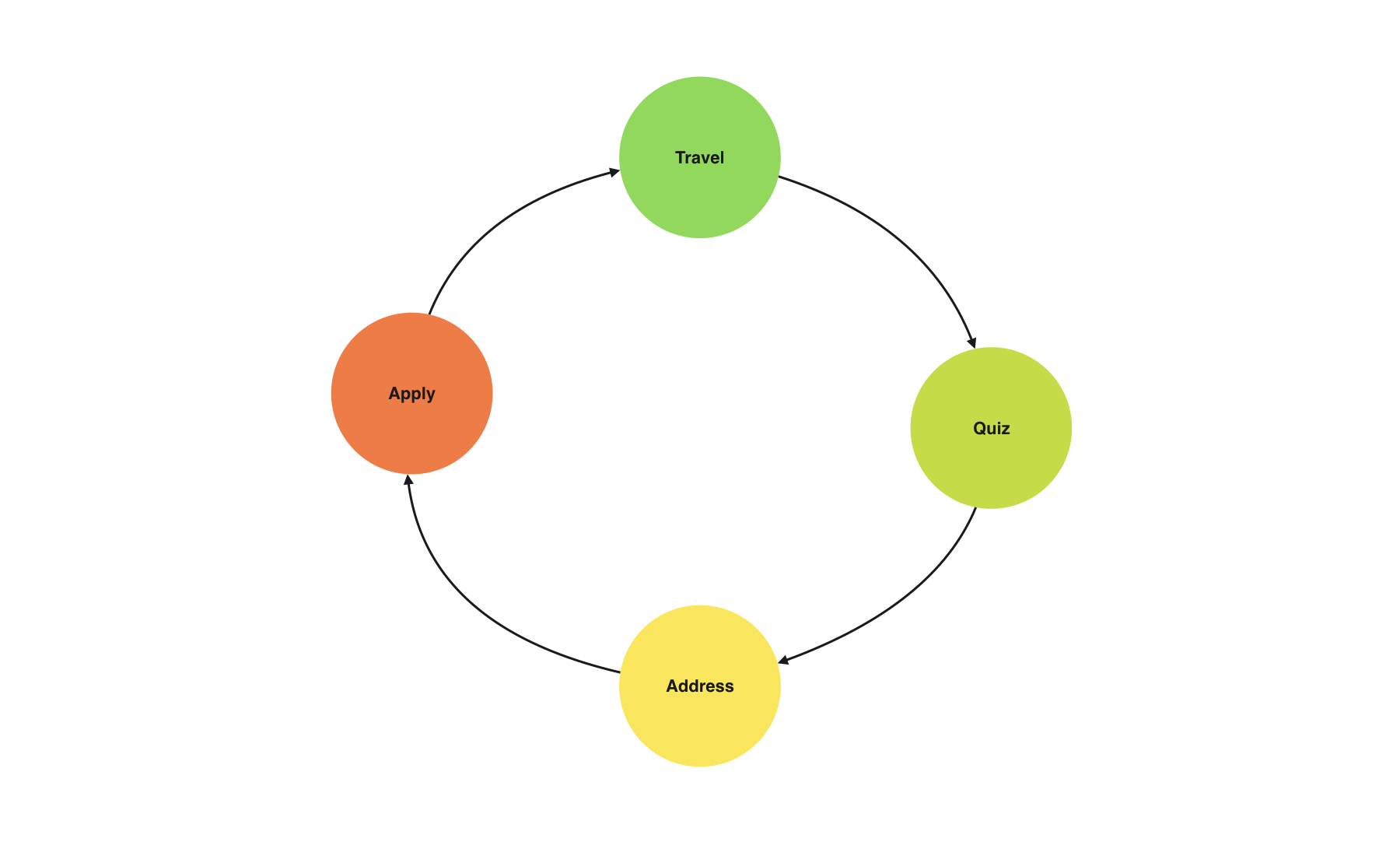
Using this novel – if a little weird – approach, you are forced to imagine that you’ve gone ahead and made the decision that you’re proposing.
The pre-mortem invites you to imagine you’re sat in a meeting room 6 months after the decision was made and you have the results of your decision in front of you.
How it works
- Step 1 – travel 6 months into the future and force yourself to list the things that went wrong as a result of the decision you made.
- Step 2 – quiz yourself on why these things went wrong.
- Step 3 – now imagine how you might have addressed each of these problems if you’d had the benefit of foresight.
- Step 4 – apply these insights to the present day.
For example, you might be deciding whether to launch a new B2B product alongside your B2C offering. Using the pre-mortem techniques, you imagine you’ve launched the product and you discovered that:
- There was no real appetite for the product in the verticals you originally earmarked
- The sell required a large amount of hand-holding to get customers onboarded
- The price was too high and customers weren’t willing to pay for it
These are all hypothetical downsides which might happen in the future but spending some time hypothesizing what might happen gives you an opportunity to take action in the present moment to address these problems and ultimately help you decide whether to go ahead with the option you’re considering.
3. Data-driven decisions
What data do you have to suggest this might be a good idea?
It sounds pretty straight forward – and it is. But a surprising number of organisations still take big decisions in the absence of any data. Yes, there is always a compelling case for making decisions based on the gut instinct of a visionary genius but most of us aren’t visionary geniuses.
If you’re keen to explore which metrics might be useful to measure for your product, here’s a selection of metrics that matter to product teams.
4. The genuine exploration of possible options

‘The only other thing we could do is…’
I often hear this phrase expressed by product teams (and find myself saying it too, of course!). There is rarely only one other thing you could do. Instead, at the start of a decision making process, list as many options as possible, even ones which seem absurd.
If you find yourself or a team member using this phrase, correct them – in a polite way of course 🙂 . They’ll find you extremely annoying at first, but over time they will gradually stop using it and become more creative in their approach to problem solving and decision making.
One of the most important parts of making decisions is exploring different options. Opening up your potential routes will help you to eventually narrow down your choices, but only after you’ve put in some up front effort to explore all the options you have on the table. Inviting team members to contribute to your options means you’ll have a wide range of perspectives feeding into your potential routes which can lead to better outcomes too.
5. Experiment / hypothesis-driven decision making
Decisions are ultimately hypotheses which need testing. This approach sees you practically creating hypotheses and ideating ways you might test these hypotheses.
Your hypotheses is a testable statement.
For example:
From here you can ideate ways of testing whether this is a sound assumption, and ultimately whether the decision to sell a SaaS product at $79 per month is viable.
The benefit of this approach is that it changes the way your organisation thinks about decisions. Yes, there are different types of decisions which vary in their degree of reversibility, but framing decisions as bets, tests and hypotheses helps to focus everyone to think in terms of experimentation rather than definitive decision making.
6. Goal / OKR oriented decisions
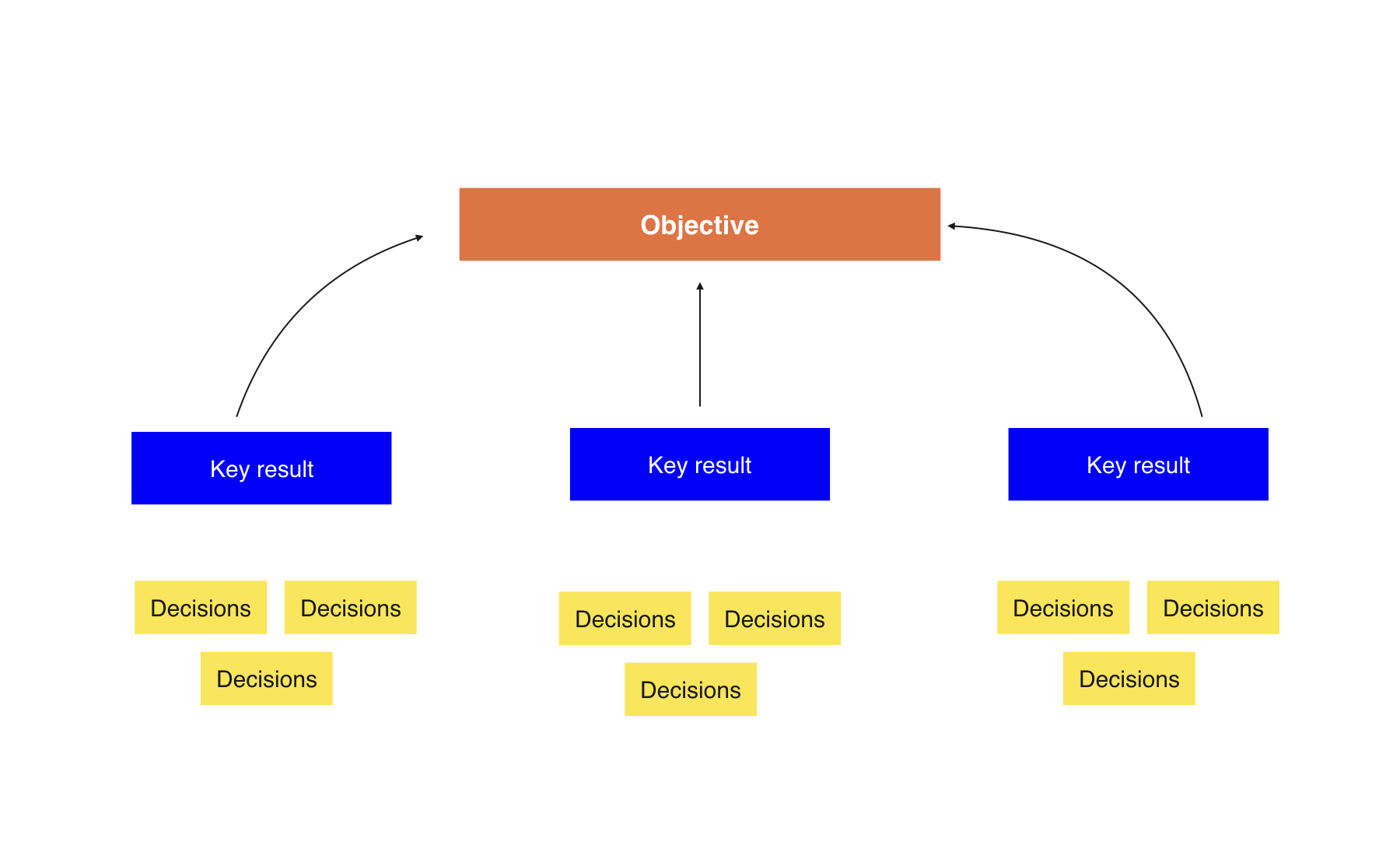
Most modern product companies adopt the product squad model with common shared goals. Your goals not only help to focus your team’s priorities but can also help shape decisions.
If you find yourself in a situation where you’re not sure what to do next, refer back to your goals or Key Results. If one or many of the options don’t align with your goals, don’t choose them.
Dealing with decision-making paralysis
‘How do you make decisions in your company? We don’t.’
– a former colleague of mine when asked about their decision making process.
In some companies, it’s not decisions that are problematic, but the absence of them.
If you’ve ever left a long meeting and thought to yourself ‘what exactly have we decided?’, you’re not alone.
Generally, the people best placed to make decisions are the ones who are closest to the problem. However, on occasion, decision making paralysis occurs when despite you’re stuck in stalemate. If none of the practical tools we’ve covered help, here’s a few alternative ways to tackle decision-making paralysis:
- Agree to experiment with 2 options – particularly helpful with design disagreements, if you have the resource, time and a genuine benefit from the insights you’ll learn, you might want to experiment with the 2 or more options on the table. This does have a slight hint of trying to keep everyone happy all of the time but will allow you to test and learn which option is best.
- Revert to authority – flat org structures are all the rage these days, but sometimes there is a case to push a decision up the chain to get input from seniors. This will give you clarity on how to proceed but the downside is that you’ll end up looking a little like squabbling kids who can’t sort out their own problems. It’s best to reserve this for decisions which have a strategic impact as opposed to more tactical decisions.
- Democratise – voting on ideas can also help. Explore all your options and then put them to a vote between the parties who disagree.
- Steamroll ahead – an important part of product management is being assertive where necessary. If you’ve been stuck in paralysis for an unhealthy amount of time, sometimes it’s best to put your neck on the line, acknowledge that there’s a disagreement but make a decision and steamroll ahead anyway.



